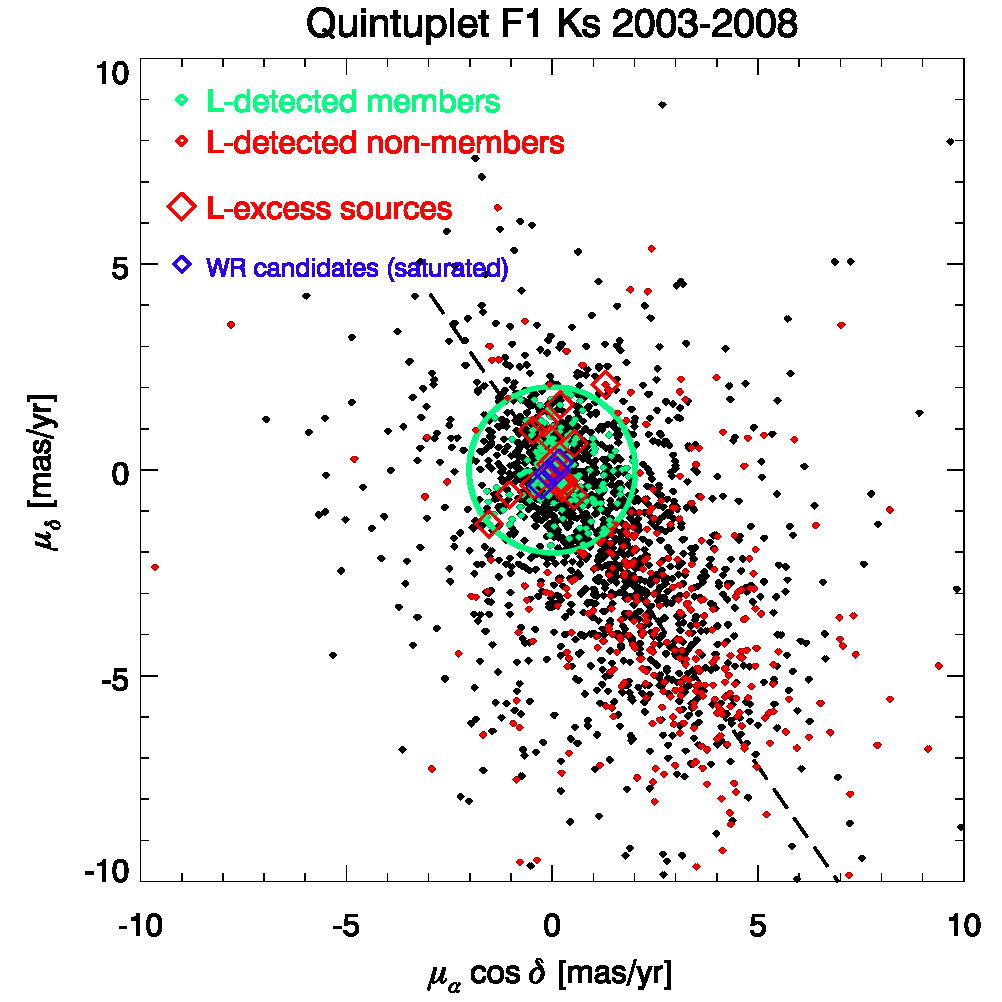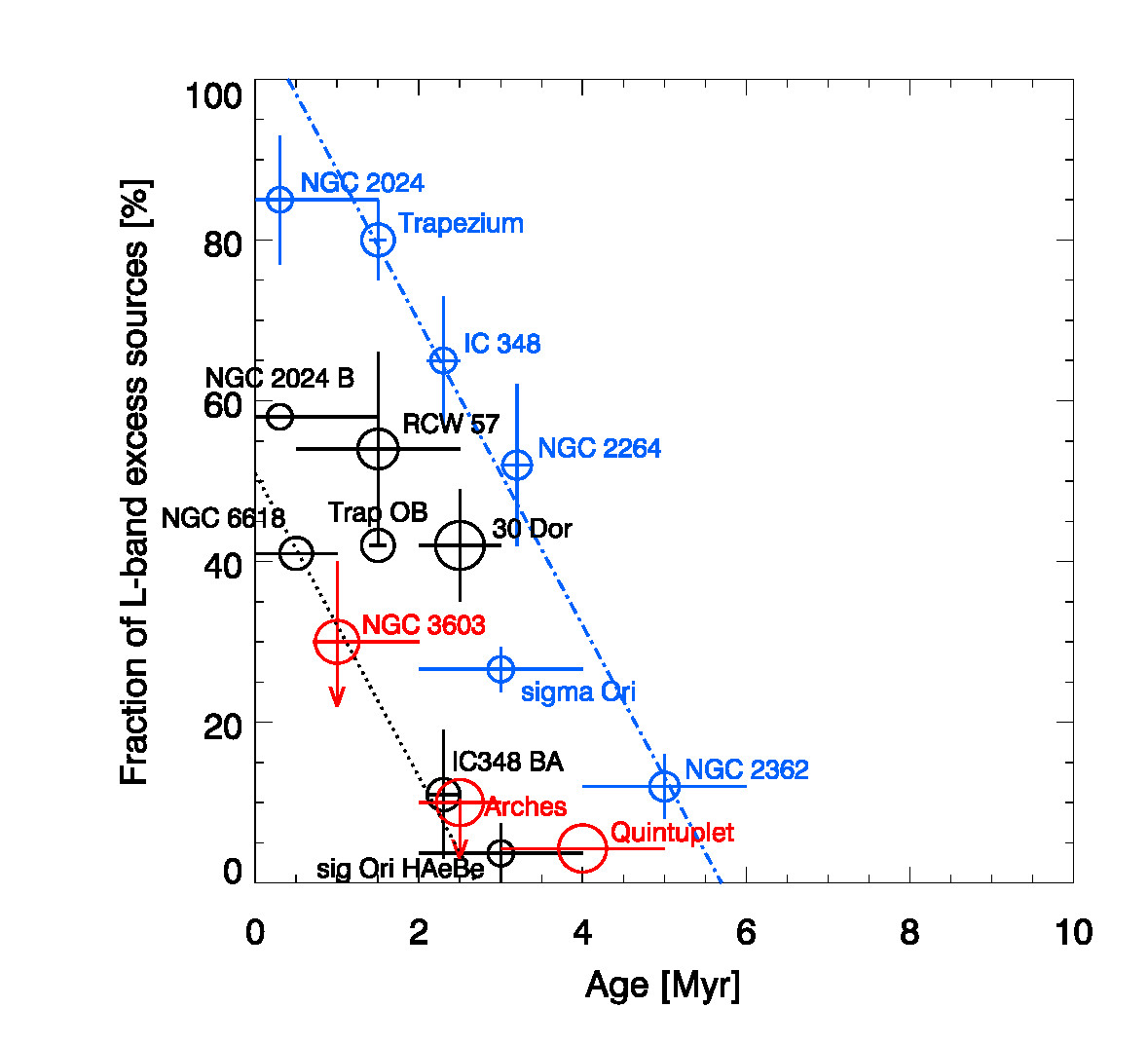Circumstellar disc survival in Milky Way starburst clusters
The second major question of the starburst cluster project was:
- Can discs survive in starburst clusters?
- How does the disc survival rate compare to moderate star-forming regions such as Orion?
- With both proper motion membership and mid-infrared observations at 3.5 micrometer wavelength, in the thermal infrared regime, we were able to estimate the fraction of circumstellar discs in each cluster. In the Arches and Quintuplet clusters, we find disc rates of approximately 4% to 9% at the respective cluster ages of 2.5 and 4 Myr. Almost all of the objects with enhanced thermal emission were confirmed as cluster members. This implies that circumstellar discs were able to survive the harsh cluster environment over extended periods of several millions of years. Alternatively, there must be a mechanism that allows dense circumstellar discs to form at a later stage during the cluster evolution.
Disc survival is unexpected in starburst clusters
In the dense environment of starburst clusters, circumstellar discs
are exposed to the intense UV radiation from high-mass neighbours,
to stellar winds, and to close-by encounters that might lead to
gravitational disruption of circumstellar material.
On first glance, the very low fractions of only 4-9% of discs
seem to confirm that discs in starburst clusters dissolve more
quickly than in moderate star-forming environments.
However, the disc host stars had masses of 3-15 solar masses!
The strong UV radiation of these massive stars are expected
to disrupt circumstellar material on timescales of less than 1 Myr
even without the aid of their supermassive neighbours.
This disruption timescale is much shorter than the cluster lifetime.
Disc survival or refueling?
Given our discovery of discs in both Galactic center clusters, we discuss the possibility that the circumstellar material is freshly refueled by binary mass transfer (Stolte et al. 2015). Hence, we speculate that these discs might be secondary discs instead of native, primordial survivors. This would then be the first case where the binary interaction and mass flow between two massive stars was directly observed. Whether or not this scenario can explain the observed thermal radiation needs to be confirmed by future instruments and telescopes with even substantially higher resolution than we were able to achieve.
The first discs discovered in the Quintuplet cluster
Location of stars with circumstellar material in the Quintuplet & Arches clusters
The disc fraction in comparison to young Milky Way clusters
Comparison to NGC 3603
Stolte, A., Hußmann, B., Olczak, C., Brandner, W., Habibi, M., Ghez, A. M., Morris, M. R., Lu, J. R., Clarkson, W. I., Anderson, J. 2015:
Circumstellar discs in Galactic centre clusters: Disc-bearing B-type stars in the Quintuplet and Arches clusters
Astronomy & Astrophysics, 578, A4
Stolte, A., Morris, M. R., Ghez, A. M., Do, T., Lu, J. R., Wright, S. A., Ballard, C., Mills, E., Matthews, K. 2010:
Disks in the Arches Cluster---Survival in a Starburst Environment
Astrophysical Journal, 718, 810
Hußmann, Benjamin, PhD thesis, University of Bonn, 2014:
The Quintuplet Cluster: A young massive cluster study based on proper motion membership
Kudryavtseva, N., Brandner, W., Gennaro, M., Rochau, B., Stolte, A., et al. 2012:
Instantaneous Starburst of the Massive Clusters Westerlund 1 and NGC 3603 YC
Astrophysical Journal Letters, 750, 44
Stolte, A., Brandner, W., Brandl, B., Zinnecker, H., Grebel, E. K. 2004:
The Secrets of the Nearest Starburst Cluster. I. Very Large Telescope/ISAAC Photometry of NGC 3603
see also:
Harayama, Y., Eisenhauer, F., Martins, F. 2008:
The Initial Mass Function of the Massive Star-forming Region NGC 3603 from Near-Infrared Adaptive Optics Observations
Astrophysical Journal, 675, 1319
Martins, F., Hillier, D. J., Paumard, T., Eisenhauer, F., et al. 2008:
The most massive stars in the Arches cluster
Astronomy & Astrophysics, 478, 219





